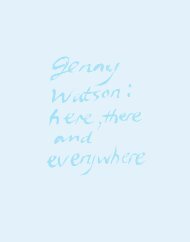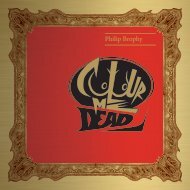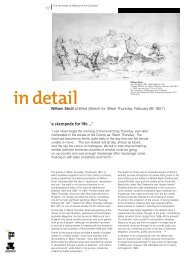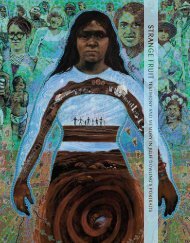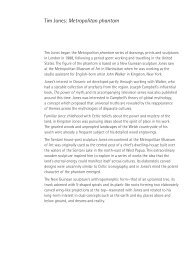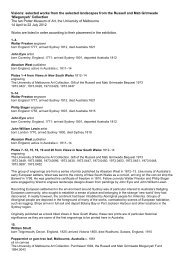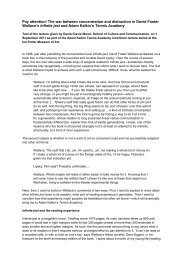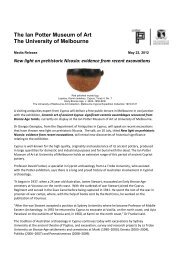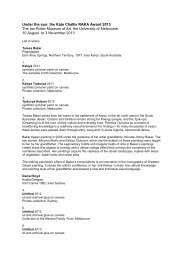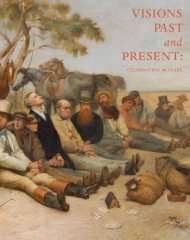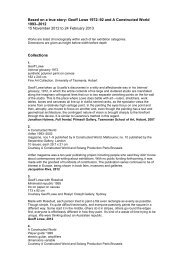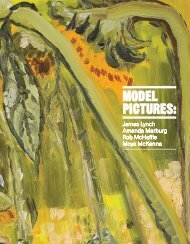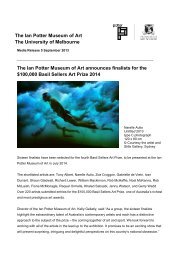The drowned world Jon Cattapan works and collaborations
Catalogue - Ian Potter Museum of Art - University of Melbourne
Catalogue - Ian Potter Museum of Art - University of Melbourne
- No tags were found...
You also want an ePaper? Increase the reach of your titles
YUMPU automatically turns print PDFs into web optimized ePapers that Google loves.
Cat. 1 Bananas 1977–78<br />
<strong>Cattapan</strong> is more inclined to mark the stages of his<br />
development with references to pop <strong>and</strong> street culture<br />
than to artistic epiphanies. <strong>The</strong> first, <strong>and</strong> still one of the<br />
most important of these was the irruption of punk rock<br />
within Melbourne’s music, fashion <strong>and</strong> literary scenes.<br />
<strong>The</strong> brash, do-it-yourself attitude of punk was liberating<br />
for a young student still unsure of his capacities <strong>and</strong><br />
qualities as an artist; ‘We felt like anybody could get<br />
up <strong>and</strong> have a go at it’.<br />
A sense of creative community developed, <strong>and</strong> with it,<br />
the first of the geographical <strong>and</strong> social territories that<br />
would appear in <strong>Cattapan</strong>’s work: ‘It was very interesting<br />
living in St Kilda in the early ’80s because you didn’t<br />
just have visual artists. You had young writers <strong>and</strong> young<br />
musicians, <strong>and</strong> they all talked to each other. You had<br />
one café that everyone went to, the Galleon, upstairs<br />
in Acl<strong>and</strong> Street. You’d bump in to half a dozen people<br />
working in different art forms’. 2 Bananas (1977–78),<br />
begun while <strong>Cattapan</strong> was still a student, refers to<br />
another punk hangout: the long-defunct music venue<br />
on St Kilda’s Upper Esplanade. Op shop fashions,<br />
pointy boots <strong>and</strong> sunglasses after dark set the tone<br />
of this <strong>and</strong> other <strong>works</strong> of the late 1970s.<br />
St Kilda’s bohemians didn’t form a movement but punk<br />
gave legitimacy to the raw, emotional style that<br />
<strong>Cattapan</strong> <strong>and</strong> his friend Peter Ellis were developing.<br />
Repressed <strong>and</strong> forgotten aspects of modernism<br />
reappeared; the expressionist James Ensor was a<br />
favourite. <strong>The</strong> return to figuration sweeping European<br />
art was echoed in the rediscovery of local mavericks<br />
such as Danila Vassilieff. <strong>The</strong> moves seem familiar in<br />
retrospect but were confronting after the cool reserve<br />
of 1970s abstraction <strong>and</strong> conceptualism. Throughout<br />
the first half of the 1980s, critics scolded <strong>Cattapan</strong><br />
as an artist with ‘disturbing <strong>and</strong> macabre fantasies’<br />
<strong>and</strong> ‘much sorting out to do’. 3<br />
For <strong>Cattapan</strong>, the studio <strong>and</strong> the street were just the<br />
place to sort things out. Outside his flat on Grey Street,<br />
St Kilda, there was never a dull moment. Haggard faces,<br />
eviscerated bodies <strong>and</strong> eerie toy-like figures all<br />
registered the rough poetry of late nights <strong>and</strong> long<br />
parties.<br />
By the mid-1980s, <strong>Cattapan</strong>’s urban imagery had<br />
become less confronting. Time spent in Europe<br />
in 1978 had amplified punk <strong>and</strong> expressionistic<br />
impulses. A second sojourn in 1985 lead to a deliberate<br />
decision to focus on the psychological spaces of the<br />
city. Some significant formal strategies were developed<br />
to pursue this goal. <strong>The</strong> grounds of the paintings<br />
became open, flattened fields of aqueous colour.<br />
Localities <strong>and</strong> incidents hovered in indistinct spaces,<br />
popping into focus with the sharp but jumpy clarity<br />
of a dream. Physical forms, such as people <strong>and</strong><br />
buildings, became more schematic as <strong>Cattapan</strong> forged<br />
a kind of Freudian hieroglyphics which referred to<br />
home, desire <strong>and</strong> travel through simple outlines <strong>and</strong><br />
silhouettes. <strong>The</strong> gridded drawings of the early 1980s<br />
grew into large, multi-panel canvases—the reactive<br />
studies—each of which offered a ‘screen in screen’<br />
detail or commentary on an adjacent event.<br />
Name <strong>and</strong> address (1988), was still based on St Kilda’s<br />
nocturnal theatre. Still living on Grey Street, <strong>Cattapan</strong><br />
witnessed a police sweep in which entire blocks were<br />
closed off while pedestrians were questioned. This<br />
moment has haunted <strong>Cattapan</strong>’s art since. <strong>The</strong> elevated<br />
point of view that dominates the later cityscapes<br />
is there, as is the gloomy dream twilight. While the<br />
incident involved a crude round-up, rather than<br />
sophisticated technological surveillance, there is an<br />
air of Orwellian social control. <strong>The</strong> painting is a<br />
harbinger of later <strong>works</strong>, such as Curtain line (Australian<br />
crowd no. 2) (2001) <strong>and</strong> <strong>The</strong> taking of Richmond (1999),<br />
in which containment <strong>and</strong> the confrontation of<br />
communities take on an explicitly political cast.<br />
Cinema showed <strong>Cattapan</strong> the way at this time.<br />
Scorsese’s Mean streets (1973) <strong>and</strong> Taxi driver (1976)<br />
mapped the city’s heart of darkness. Fellini’s Roma<br />
(1972) presented the eternal city as a movable feast of<br />
history, memory <strong>and</strong> sexuality. And Hitchcock revealed<br />
the Freudian subtexts of urban life, in dramatic<br />
eruptions of sex <strong>and</strong> violence from beneath the banal<br />
surface of the everyday.<br />
<strong>Cattapan</strong>’s cities became increasingly abstract over the<br />
course of the 1990s. An extended stay in New York in<br />
1989–90 had the paradoxical effect of dissolving, rather<br />
than consolidating, his vision of urban space. Paintings<br />
such as Documentary (Melbourne as Rome) (1989)<br />
had fantasized about life in a cosmopolitan metropolis.<br />
Real life in a mega-city was so overwhelming that<br />
<strong>Cattapan</strong> sought solace in canvases emptied of<br />
incident, like Dog day (Seep) (1991), or, as in the case<br />
of Double ellipse (from ‘<strong>The</strong> city submerged’) (1991),<br />
dissolved the city into a droplet of oily colour.<br />
6



